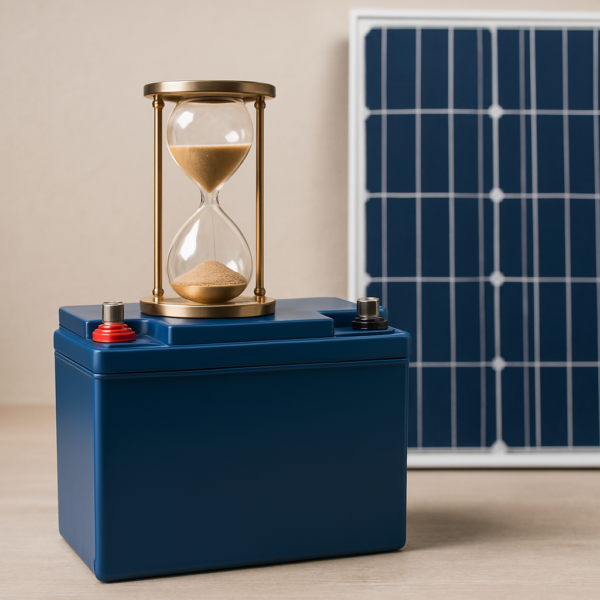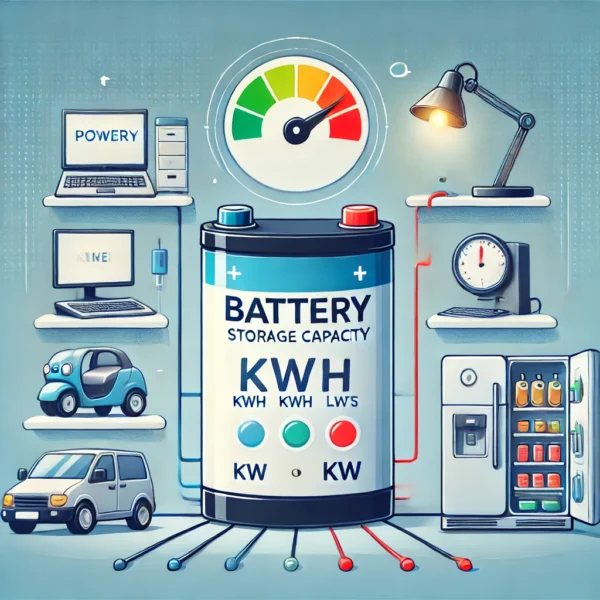Besorgt darüber, wie lange Ihre Solarbatterien tatsächlich halten werden? Das Ersetzen kann teuer sein. Das Verständnis ihrer wirklichen Lebensdauer hilft Ihnen, besser zu planen und Geld in der Straße zu sparen.
Solarzbatterien dauern normalerweise dazwischen 5 Und 15 Jahre. Die genaue Dauer hängt stark vom Batterie -Typ ab (Wie Lithium oder Blei-Säure), Wie oft benutzt du es (Lebensdauer), Umweltbedingungen, und die spezifische Marke oder Qualität.

Das gibt Ihnen eine allgemeine Vorstellung davon, was Sie erwarten können. Aber Sie haben wahrscheinlich spezifischere Fragen, like how often you’ll actually need to swap them out or what ‘life expectancy’ really means. Let’s dive into those details to give you a clearer picture.
Wie oft müssen Solarzbatterien ersetzt werden?
Wondering exactly when you’ll face the cost and hassle of replacing your solar battery? Unerwartete Fehler und Ausfallzeiten sind definitiv stressig. Wenn Sie den typischen Ersatzzyklus kennen.
Im Allgemeinen müssen Sie alle Sonnenbatterien ersetzen 5 Zu 15 Jahre. This timeframe often aligns with the manufacturer’s warranty period. Moderne Lithiumbatterien halten normalerweise länger und erfordern einen geringeren häufigen Ersatz im Vergleich zu älteren Blei-Säure-Typen.

Tiefer in Ersatzzyklen graben
Die Notwendigkeit eines Austauschs läuft auf einige wichtige Dinge hinaus. Das Wichtigste ist Lebensdauer1. Ein Zyklus ist eine vollständige Ladung und Entladung. Die Batterien werden für eine bestimmte Anzahl von Zyklen bewertet, bevor ihre Kapazität erheblich sinkt. Zum Beispiel, bei gycxSolar, Die Lithiumeisenphosphat (LiFePO4) Batterien2 Wir empfehlen oft, dass Händler bewertet werden 5,000-6,000 Fahrräder. Wenn Sie es einmal am Tag radeln, that’s well over 10 Lebensjahre. Die Marke und Qualität der Batteriezellen im Inneren spielen hier eine große Rolle, was auch den Preis beeinflusst.
Ein weiterer Faktor ist Entladungstiefe (DoD)3. Dies bedeutet, wie viel Energie Sie vor dem Aufladen nutzen. Eine Batterie regelmäßig zu entleeren, verkürzt seine Lebensdauer vollständig. Die meisten Lithiumbatterien verarbeiten tiefe Entladungen (wie 80-90% DoD) viel besser als Bleibatterien, die flacheren Zyklen bevorzugen.
Temperatur Dinge auch. Extreme Hitze oder Kälte können die Batterieleistung und die Lebensdauer beeinträchtigen. Batterien in einem Stall halten, Mittelschwere Temperaturumgebung hilft ihnen, länger zu dauern.
Hier ist ein einfacher Vergleich:
| Besonderheit | Lithium (LiFePO4) | Lead-Säure |
|---|---|---|
| Typische Zyklen | 5,000 - - 10,000+ | 300 - - 1,500 |
| Typische Lebensdauer | 10 - - 15+ Jahre | 3 - - 7 Jahre |
| Nutzbare Kapazität | 80% - - 100% DOD -Toleranz | 30% - - 50% Empfohlener DoD |
| Wartung | Minimal | Regulär (Z.B., Wasseraufladung) |
Ich erinnere mich. Während es anfangs für seine Bedürfnisse mit geringer Leistung funktionierte, Die häufigen Ersetzungen wurden länger langfristiger und potenziell teurer als in Lithium im Voraus in Lithium. Das Verständnis dieser Faktoren hilft Ihnen, mit Bedacht zu wählen.
Was ist die Lebenserwartung von Sonnenbatterien??
Confused by terms like ‘life expectancy’ versus ‘warranty period’? Die falsche Annahme auf der Grundlage dieser Begriffe kann zu einer schlechten Investition führen. Lassen Sie uns klarstellen, was die Lebenserwartung wirklich für Ihr Solar -Batterie -System bedeutet.
Die Lebenserwartung bezieht sich auf die typische betriebliche Lebensdauer, die Sie vernünftigerweise von einer Batterie bei normalem Gebrauch erwarten können, oft 5 Zu 15 Jahre oder mehr. Dies unterscheidet sich von der Garantie, which is a manufacturer’s guarantee against defects for a specific period.

Lebensdauer verstehen vs. Garantie
Think of life expectancy as the battery’s realistic working life before its ability to hold a charge significantly decreases (Normalerweise definiert als weniger als halten 70-80% seiner ursprünglichen Kapazität). Der Garantie is the manufacturer’s promise to replace the battery if it fails due to manufacturing defects within a set time (Z.B., 5, 10, oder auch 15 Jahre für einige Premium -Lithiumbatterien). Eine Batterie kann weit über die Garantiezeit hinausarbeiten, Erreichen der vollen Lebenserwartung.
Mehrere Dinge beeinflussen die tatsächliche Lebenserwartung:
- Batteriechemie: Wie ich erwähnte, Lithium -Eisenphosphat (LiFePO4) ist heute eine gemeinsame Wahl, bessere Sicherheit, und höhere Effizienz im Vergleich zu herkömmlichen Blei-Säure-Batterien. Dies führt direkt zu einer längeren Lebenserwartung, Oft übertroffen 10 Jahre. Wir konzentrieren uns auf diese bei gycxSolar, da sie unseren Kunden einen besseren langfristigen Wert bieten.
- Nutzungsmuster: Wie tief und wie oft Sie die Batterie entladen (DOD und Zyklen) Beeinträchtigt erheblich die Lebensdauer. Die sanftere Verwendung verlängert die Lebensdauer.
- Betriebsumgebung: Extreme Temperaturen sind schädlich. Ein klimatisierter Ort ist ideal.
- Wartung: Blei-Säure-Batterien erfordern regelmäßige Schecks und Wartung (wie Flüssigkeitsspiegel überprüfen). Lithiumbatterien sind praktisch wartungsfrei, Beitrag zu ihrer Benutzerfreundlichkeit und potenziell längere effektive Lebensdauer leisten.
Ich empfehle den Kunden oft, über die Vorabkosten hinauszuschauen. Berücksichtigen Sie die Gesamtbesitzkosten, Berücksichtigung der erwarteten Lebensdauer und potenziellen Ersatzkosten. Eine länger anhaltende Lithiumbatterie kann einen höheren Anfangspreis haben, erweist sich jedoch oft wirtschaftlicher 15-20 Jahre.
Wie lange dauert eine voll aufgeladene Sonnenbatterie??
Müssen Sie schätzen, wie lange Ihre Backup -Leistung die Dinge während eines Ausfalls tatsächlich am Laufen hält? Es ist wirklich frustrierend, aus dem Saft unerwartet auszurichten, wenn Sie davon abhängig sind. Das Verständnis von Entladungsfaktoren hilft Ihnen, die Dauer genau zu berechnen.
Wie lange eine voll aufgeladene Batterie dauert, hängt ganz von zwei Dingen ab: the battery’s storage capacity (gemessen in Kilowattstunden, kWh) und die Menge an Strom, die Ihre verbundenen Geräte zeichnen (gemessen in Kilowatt, kW).

Berechnung der Laufzeit: Kapazität und Last
It’s a pretty straightforward calculation, Aber Sie brauchen die richtigen Zahlen. Die Grundidee ist:
Runtime (in hours) = Battery Capacity (in kWh) / Power Load (in kW)
Jedoch, there’s a catch: you usually don’t discharge the battery to 0%. Sie müssen die berücksichtigen Entladungstiefe (DoD) Beschränken Sie die empfohlene für Ihren Batterie -Typ, um die Gesundheit zu erhalten. Für Lithiumbatterien, das könnte sein 80% oder 90%. Für Blei-Säure, it’s often closer to 50%.
Also, Die realistischere Formel ist:
Runtime (hours) = (Battery Capacity (kWh) * DoD (%)) / Power Load (kW)
Zum Beispiel, let’s say you have a 10 kWh Lithiumbatterie mit a 90% DOD -Grenze, und Sie führen Geräte aus, die eine Konstante ziehen 1 kW der Macht.
Runtime = (10 kWh * 0.90) / 1 kW = 9 hours
Ihr tatsächlicher Belastung wird variieren. Ein Kühlschrank kann 150W verwenden, Lichter vielleicht insgesamt 50W, Während eine Mikrowelle 1200W verwendet (1.2 kW). Sie müssen die Gesamtleistung der wesentlichen Schaltungen schätzen, die die Batterie sichern soll. Ich empfehle Kunden immer, ihre kritischen Geräte aufzulisten, um ihre erforderliche Kapazität realistisch zu berechnen. Stellen Sie sicher, dass die Batteriegröße Ihren Sicherungsanforderungen entspricht.
Wie lange dauert eine 10 kWh Solar -Batterie??
Versuch, ein praktisches Gefühl dafür zu bekommen, was für eine bestimmte Batteriegröße, Wie 10kwh, Mittel für die Sicherungskraft? Fehleinkommen, wie lange es dauern wird, kann Sie ohne Strom verlassen, wenn Sie es brauchen. Let’s calculate the runtime for this common battery capacity.
Eine 10 -kWh -Sonnenbatterie könnte eine kontinuierliche 1 kW -Last für ungefähr mit Strom versorgen 9-10 Std., assuming you don’t drain it completely (Respektation seiner Entladungstiefe). Die genaue Zeit hängt stark von Ihrem tatsächlichen Stromverbrauch ab.

Laufzeitbeispiele für eine 10 kWh Batterie
Erste, let’s clarify: "10 kW Batterie" bezieht sich normalerweise auf 10 Kilowattstunden (kWh), die Energiespeicherkapazität misst, nicht Kilowatt (kW), die Leistungsausgangsrate misst. Dies ist ein häufiger Verwirrungspunkt, den ich sehe.
Mit unserer Formel Runtime = (Capacity * DoD) / Load, let’s see how a 10kWh lithium battery (mit einem Safe 90% DoD, geben 9 kWh nutzbare Energie) führt unter verschiedenen Lasten durch:
| Kontinuierliche Leistungsbelastung | Berechnung | Geschätzte Laufzeit | Typische Geräte abgedeckt |
|---|---|---|---|
| 500 Watts (0.5 kW) | (10 kWh * 0.9) / 0.5 kW | 18 Std. | Kühlschrank, Beleuchtung, Wi-Fi-Router, Laptop -Ladung, Fernseher |
| 1000 Watts (1.0 kW) | (10 kWh * 0.9) / 1.0 kW | 9 Std. | Über + Vielleicht eine Mikrowelle (kurz verwendet) oder Sumpfpumpe |
| 2000 Watts (2.0 kW) | (10 kWh * 0.9) / 2.0 kW | 4.5 Std. | Über + Vielleicht eine kleine elektrische Heizung oder Kaffeemaschine |
Erinnern, your household load isn’t usually constant. Es schwankt, wenn Geräte ein- und ausschalten. Eine 10 -kWh -Batterie hat eine beliebte Größe, da sie häufig über Nacht oder durch einen erheblichen Teil eines Ausfalls für ein durchschnittliches Zuhause wesentliche Lasten abdecken kann.
Ich habe kürzlich mit einem Kunden zusammengearbeitet, der zwischen einem 5 -kWh und einem 10 -kWh -System diskutiert hat. Durch Auflistung ihrer wesentlichen Geräte (Kühlschrank, Gefrierschrank, Beleuchtung, Internet, medizinisches Gerät) und Schätzung ihrer Verwendung während eines Ausfalls, Wir haben herausgefunden, dass das 5kwh es zu nahe zum Komfort schneiden würde. Die 10kwh lieferten die Seelenfrieden, die sie brauchten. Kunden zu helfen, die Batteriegröße mit ihren tatsächlichen Bedürfnissen zu entsprechen, ist ein großer Teil dessen, was wir bei GycxSolar tun.
Abschluss
Also, Die Lebensdauer der Sonnenbatterie variiert variiert, hauptsächlich basierend auf Typ und Verwendung. Lithiumbatterien dauern oft 10+ Jahre. Kapazität verstehen, Belastung, Und DOD sagt Ihnen, wie lange Ihre Kraft anhält.
Das Verständnis der Zykluslebensdauer ist entscheidend für die Entscheidung über die Auswahl der Batteriee, Gewährleistung der Langlebigkeit und Effizienz in Ihren Energielösungen. ↩
Entdecken Sie die Vorteile von LifePO4 -Batterien, einschließlich Langlebigkeit und Effizienz, Um bessere Energiespeicherentscheidungen zu treffen. ↩
Das Erkunden von DOD kann Ihnen helfen, die Batterieverwendung zu optimieren, Leistung verbessern und die Lebensdauer erheblich verlängern. ↩
